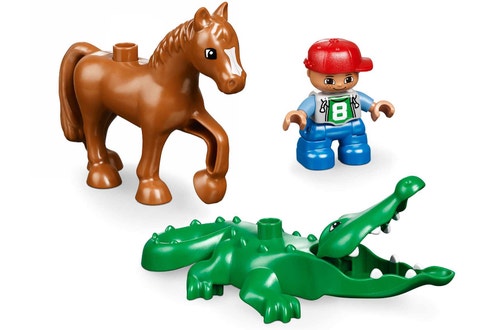Characters
Learn about story characters and fundamental narrative structure and elements.

Prepare
Review this lesson plan and choose what you need from the Teacher Support box.
If necessary, pre-teach these related vocabulary words: story, character, physical characteristics, personality traits.
Consider the abilities and backgrounds of all your students and decide when and how to introduce and differentiate lesson content, activities, or concepts.
If the background cards are missing or broken, you can download them from the Additional Resources section of the Teacher Support box.
Connect
Prompt a discussion about stories by asking the students to name a story they have heard. If they have difficulty recalling a story, remind them of stories you have recently read in class.
Talk about the people and animals in these stories. Explain that they are called characters, and they are very important to the story because all of the action revolves around them.
Ask the students to name the characters in the stories they mentioned.
Show the students a few of the StoryTales figures and animals, and tell them that these will be characters in their stories.
Model how to describe a character by talking about its characteristics.
Construct
Tell the students it is time to play a character game.
Choose a figure or animal without letting anyone see it. Describe it while the students guess which one it is. The student who guesses the character can keep it for the rest of the game.
Contemplate
Encourage a discussion about characteristics.
Consider asking questions like:
- What kinds of characteristics can you name?
- Was it difficult thinking of all the characteristics? Why or why not?
- Why is it important to describe characters in a story?
Tell the students that the characteristics they have been discussing are physical characteristics. Explain that this means they describe how a character looks, and that physical characteristics are important in a story because they help the audience picture the character.
Tell them that it is even more important to understand how characters behave. Explain that these behaviors are called personality traits, then give some examples (e.g., a horse might be brave and caring).
Continue
Play the character game again. Place all the characters in a bag and have one student pick a character without showing it to anyone. Encourage him or her to act like the character by making sounds and movements.
The rest of the students will try to guess which character is being described. If they have trouble, help them identify the appropriate characteristics.
Did you notice?
- Ask guiding questions to elicit students’ thinking and their decisions while ideating.
Observation Checklist
Review the learning objectives and educational standards addressed in this lesson (Teacher Support box).
Share specific student responses and behaviors at different levels of mastery.
Use the following checklist to observe students’ progress:
- Students are able to describe things and events.
- Students are able to, with prompting and support, identify characters in the story.
Teacher Support
Students will:
- Explore the StoryTales components.
- Learn about story characters.
- Use descriptive language.
For up to 6 students.
CCSS.ELA-LITERACY.RL.K.3 With prompting and support, identify characters, settings, and major events in a story.




